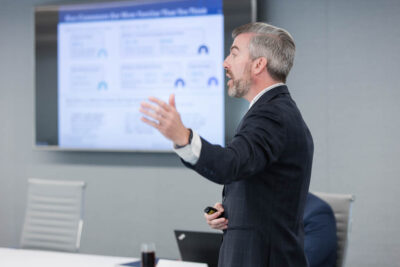Improving employee engagement through continuous feedback
March 2, 2022
Alana Lardizabal
Director of Human Resources, Southern Oregon University
The views and opinions expressed are those of the author and do not necessarily represent the views or opinions of EAB.
In 2018, Southern Oregon University updated its Strategic Plan to become an inclusive, sustainable university for the future that guides all learners to develop the knowledge, capacities, and audacity to innovate boldly and create lives of purpose. In addition to the vision, mission, and values, seven distinct directions were identified and supported by 22 goals.
My capstone project concentrated on Strategic Direction II: SOU will become an employer of choice and provide excellent service to all of its constituents, Goal I: SOU will develop effective orientation, training and professional development programs, as well as a performance management process that rewards employees for continuous improvement.
Employee feedback revealed inconsistencies in performance reviews
The third element of SDII Goal I emphasizes the impact regular and continuous feedback has on employee morale, work productivity, and retention. When assessing current processes and how best to engage all staff generations in the workforce, several themes arose.
First, our employee population is roughly 55% Baby Boomers and Generation Xers who are accustomed to the traditional year-in-review annual approach to performance evaluations. Meanwhile approximately 45% of Millennials and Centennials who expect regular face time and frequent goal setting conversations that verify they are on a path with visible upward mobility.
Second, there is culture on campus that if a performance review was not conducted the employee should expect their job was performed well. This resulted in progressive discipline hesitancy and much stress and angst on both sides when a review was given.
Third, supervisors perceived the existing process as too time consuming and the data collected during employee exit interviews corroborated that only 35% felt they received regular oral feedback and 40% actually received a written evaluation.
-
35%
of employees felt they received regular oral feedback
-
40%
of employees received a written evaluation
Process changes improved the review process
To address these concerns, SOU HR took the current annual year-in-review process and digitized it by utilizing a third-party vendor. This allowed us to integrate functionality that auto-populated job duties from the certified position description (which saved time); send reminders to both the employee and supervisor for awareness of the process and timelines (which relieved angst); and monitor a built-in dashboard of real-time completion rates (allowing HR to proactively educate and coach accordingly).
To meet the preferences of multiple generations in the workforce, SOU HR created an optional quarterly, 3-, 6-, and/or 9-month check-in process that is initiated by the employee to signal to their supervisor that they are seeking more frequent and continuous feedback. This begins with the employee providing their own self-assessment of their goals and accomplishments to date.
In addition to support from executive leadership and listening to the voice of our customers, EAB was an incredible resource by presenting relevant monthly higher education topics, providing a capstone advisor, and making research material available.
“The Manager’s Guide to Accurate Evaluations” and “The Shift from Annual Performance Management to Continuous Feedback” papers contributed to this capstone project.
My capstone fellow, Breanne Holloway from Ball State University, was an invaluable resource as well. Learning of the detailed administrative efficiency process she conducted for BSU’s recruitment and hiring process provided significant insight on the importance of keeping the end user’s experience at the forefront.
More Blogs

What 30+ rising higher education leaders learned in EAB’s fall 2024 fellowship

3 types of faculty AI policies your institution needs to have
